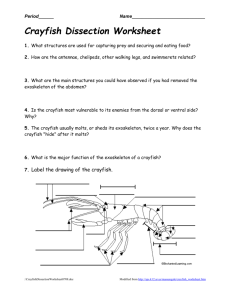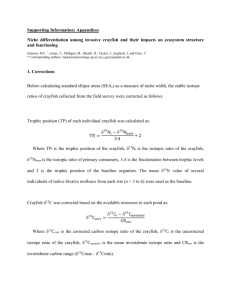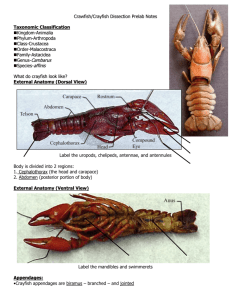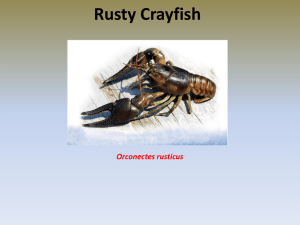Background Presentation Powerpoint
advertisement
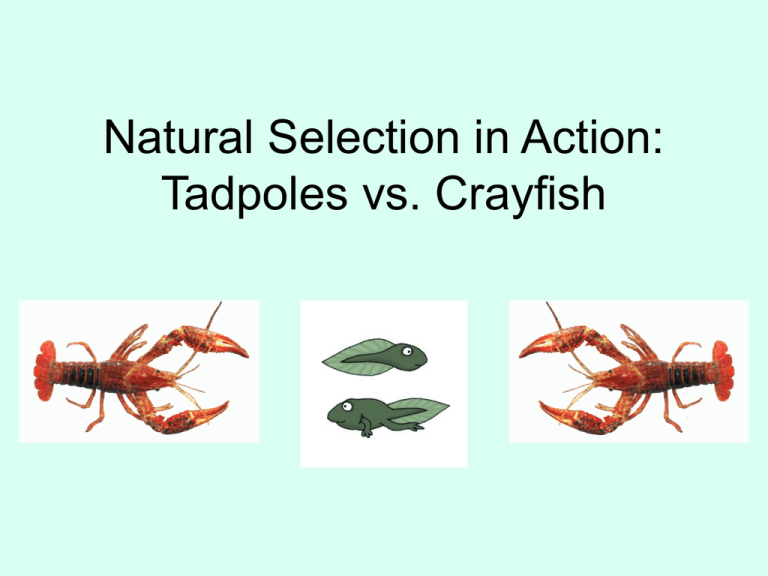
Natural Selection in Action: Tadpoles vs. Crayfish Invasive Species • What is an invasive species? – A species that is non-native to the ecosystem (not originally found there) – Presence is likely to cause environmental or economic harm – Can be plants, animals, microbes – Usually introduced to an area by humans (on purpose and accidentally) Invasive Species • Examples: Arundo donax – giant reed – Found in riparian (stream) habitats – Invasive in southern California – Displaces native plants and provides poor habitat for insects and wildlife – Fire and flood hazard Invasive Species • Examples: Argentine Ant (Linepithema humile) – Native to Argentina, invasive worldwide, also in southern CA (these are the ants you see in your house) – Displaces native ants or causes local extinctions – In southern CA, responsible for decline of native ants which are sole food source of CA horned lizard Invasive Species • Examples: Zebra mussel (Dreissena polymorpha) • Native to Russia, introduced worldwide • Change natural food webs • Huge economic impact – clog pipes, cover boats Invader: Red swamp crayfish (Procambarus clarkii ) • Invasive in southern California streams • Introduced by humans worldwide for aquaculture (eating), accidentally as bait or with fish stock • Will eat almost anything, including amphibians (eggs, Crayfish have invaded the Santa Monica Mountains Prey: Pacific treefrog tadpoles (Pseudacris regilla) • Native range from Mexico to British Columbia, Pacific coast to Montana, Nevada • Found in streams with and without crayfish in the Santa Monica Mountains but show reduced abundance in the presence of crayfish Predator Escape • What traits might help a tadpole escape from a crayfish? My Research • Predation is a strong form of natural selection • Are crayfish causing tadpoles to evolve? McCollum and Leimberger 1997 My Research • I am examining tadpoles from streams with and without crayfish and looking at anti-predator traits • I will compare morphology, behavior, and ability to survive with crayfish My Research • Tadpoles from streams with crayfish may show these adaptations: – Longer tails or bigger tail muscles – Behavioral response of hiding and swimming less when crayfish are present – Increased survival in the presence of crayfish Credits • • • • • • • • • • Slide 1: http://www.freewebs.com/siganurme/seapea.htm and http://giraffian.com/pictionaryfiles/t/tadpole.png Slide 3: http://thegreencuttingboard.blogspot.com/Arundo-donax.jpg and http://members.tripod.com/~Hatch_L/arundodonaxvar.jpg Slide 4: http://www.issg.org/database/species/ecology.asp?si=127&fr=1&sts=&lang=EN and http://news.illinois.edu/WebsandThumbs/Suarez,Andrew/argentine_ants_b.jpg and http://i.livescience.com/images/060914_ant_fight_02.jpg Slide 5: http://www.issg.org/database/species/ecology.asp?si=50&fr=1&sts=&lang=EN and http://conservationreport.files.wordpress.com/2008/11/zebra-mussel-not-wanted-poster.jpg and http://upload.wikimedia.org/wikipedia/commons/0/0b/Zebra_mussel_GLERL_3.jpg Slide 6: http://nas.er.usgs.gov/taxgroup/Crustaceans/maps/pr_clarkii.gif andhttp://naturaljapan.net/photos/Procambarus_clarkii_04.jpg Slide 7: Images from Katherine Pease Slide 8: http://www.iucnredlist.org/details/55897/0 and images from Katherine Pease Slides 9 and 11: Images from Katherine Pease Slide 10: Image from McCollum and Leimberger (1997) Oecologia Slide 12: http://www.mister-toad.com/PacificTreeFrog.html
